Reports from the Knowledge Labs about our recent findings, research topics, and interviews with lifestyle leaders who are creating their own futures.
|
|
| |
How to stimulate your own powers of foresight. Consider the following thought provokers. Ask yourself, in these categories what are the brand new trends and forces? Which are the ones growing in importance? Which current forces are loosing their steam? Which have peaked or are reversing themselves? Which are the "wildcards" about to disrupt us in the future? POLITICAL AND TECHNICAL thought for food: Electronics, Materials, Energy, Fossil, Nuclear, Alternative, Other, Manufacturing (techniques), Agriculture, Machinery and Equipment, Distribution, Transportation (Urban, Mass, Personal, Surface, Sea, Subsurface, Space), Communication (Printed, Spoken, Interactive, Media), Computers (Information, Knowledge, Storage & Retrieval, Design, Network Resources), Post-Cold War, Third World, Conflict (Local, Regional, Global), Arms Limitation, Undeclared Wars, Terrorism, Nuclear Proliferation, Weapons of Mass Destruction, Governments (More/Less Power and Larger or Smaller Scale), Taxes, Isms: Nationalism, Regionalism, Protectionism, Populism, Cartels, Multinational Corporations, Balance of Trade, Third Party Payments, Regulations (OSHA, etc.) Environmental Impact, U.S. Prestige Abroad. SOCIAL AND ECONOMIC Food for thought:
Labor Movements, Unemployment / Employment Cycles, Recession, Employment Patterns, Work Hours / Schedules, Fringe Benefits, Management Approaches, Accounting Policies, Productivity, Energy Costs, Balance of Payments, Inflation, Taxes, Rates of Real Growth, Distribution of Wealth, Capital Availability and Costs, Reliability of Forecasts, Raw Materials, Availability and Costs, Global versus National Economy, Market versus Planned Economies, Generations: Y, X, Boomers, Elderly, Urban vs. Rural Lifestyles, Affluent vs. Poor, Neighborhoods and Communities, Planned or Organic Growth.
Got Knowledge?
|
|
| |
|
|
|
|
The Journal of 2020 Foresight
|
|
| |
|
Monday, July 31, 2006
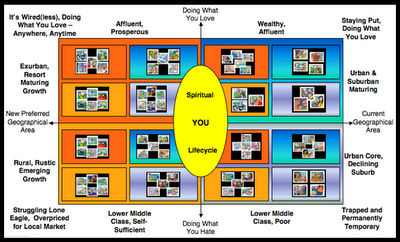
Finding and Investing in Your Own Greendale
Chapter Four: The Tribal Territories
By Steve Howard, CKO
The Knowledge Labs
Table of Contents
Chapter One: Basecamp
Chapter Two: The Ridge
Chapter Three: The Outpost
Chapter Four: The Tribal Territories
“When I was writing these songs and recording them, we had no idea what was going on. Grandpa was my favorite and when he died, I mean he had a, whatever happened, a heart attack or something … that really blew my mind.”
Neil Young & Crazy Horse “Greendale”
DOUBLE NICKEL RANCH: No one wants to find themselves in their mid-50s in a “Trapped and Permanently Temporary” predicament. Especially with so much on the line as Boomers move en mass into what had been the golden retirement years for their parents.
Journal of 2020 Foresight: How do you summarize the four future-proofing scenarios each with their four sub-categories?
Eagle: Well, first of all if it hasn’t dawned on you yet, what started out as just four qualitatively different stories about the future evolved into four sets of four community profiles.
J2020F: So we have 16 options from which to choose.
Eagle: And, one way of evaluating where you want to end up on the grid --between doing what you love or hate and remaining or moving -- is to look for the best fit.
J2020F: Determined by passions, your current life stage and future needs?
Eagle: That’s right. In our model if you aspire to or already live in one of the four communities in the “Staying Put, Doing What You Love” box what attracts you to these locations instead of the other three is a combination of wealth and affluence in more desirable urban and in maturing suburban neighborhoods.
J2020F: Like “The OC”?
Eagle: In less exaggerated ways. Their counterpart for staying in the same geographical area, “Trapped and Permanently Temporary,” plays out in urban cities and declining suburbs, but as you can guess, the neighborhoods attract the lower middle class and the poor.
J2020F: Their common story revolves around the struggle to make ends meet, right?
Eagle: Sure. And, their struggle is similar to “Struggling Lone Eagles, Overpriced for Local Markets.”
J2020F: One difference has to do with obsolescence of marketable skills, while the other has more to do with finding a market?
Eagle: Yes. Eagles remained marketable, but because they live in more rural, rustic and emerging growth communities they enjoy lower cost of living advantages that come with their emphasis on self-sufficiency.
J2020F: So, they can stretch their lower middle class incomes further.
Eagle: Yes. That leaves the affluent and prosperous citizens in the “It’s Wired(less), Doing What You Love – Anywhere, Anytime” story who populate the more well known exurban and maturing growth resorts.
J2020F: You said originally, these stories were intended to be forms of contingency plans – A, B, C and D?
Eagle: Right. If you already enjoy what you do where you live, you want to keep developing yourself to make the most of it. You want to do all you can to prevent falling into the trapped and permanently temporary scenario as you find fewer fulfilling projects to pay for the higher cost of living.
J2020F: If you don’t, what happens?
Eagle: You find yourself forced into an entrepreneurial role that you may not be suited for.
J2020F: And you may be forced to choose between community roots and the following the jobs outsourced offshore or exiting your town, right?
Eagle: If you have found yourself already in the trapped and permanently temporary scenario, when you haven't developed enjoyable and marketable skills, you may have to move to more affordable areas at longer commutes to urban centers.
J2020F: Or, you may find that you need to move to higher quality of life communities with a lower cost of living and take on a new occupation.
Eagle: We also see the model’s value fo taking advantage of real estate markets as they move through up, down and up cycles.
J2020F: Based on Dent’s predictions that Gen Y will drive rental markets and Boomers will drive vacation and retirement markets, even in a down turn?
Eagle: Yes, we’re always looking after the Boomer extended family, and as everyone knows real estate appreciation has already been a big factor in wealth generation for them.
J2020F: So, you believe you can use the model to find better deals – the no-money-down, buy at 30%-to-50%-below-market programs?
Eagle: Yes. When we consider moving to or investing in any of the 16 types of communities, we evaluate six types of real estate opportunities like those -- when to buy, how long to hold, and when to sell – based upon Craig Hall’s book, “Timing the Real Estate Market.”
J2020F: Six types?
Eagle: The primary group we focus on is single family, rental & second family homes. But, since we’re tracking the seven market cycle indicators anyway, we’re monitoring duplexes to apartment buildings; raw land; office property; hospitality – hotels & motels, as well.
J2020F: Seven market cycle indicators?
Eagle: The first is inflation – moderate (1% - 10%), hyper (above 10%) or deflation (less than 0%).
J2020F: Deflation is what Dent predicts for the beginning of the next decade.
Eagle: That’s right. The other six indicators are: interest rates, flow of funds to real estate investments, job growth, migration, path of progress and rate of new construction.
J2020F: It seems complicated, having to choose among 16 communities and to track real estate market timing indicators. Where do you begin?
Eagle: We do the hard work. You just have to start. Remember it all begins with you.
J2020F: And, then you can transplant your business or create a knowledge company?
Got Knowledge?
Copyright ©2002 - 2006 Aarnaes Howard Associates. All rights reserved worldwide.
11:12 AM
Saturday, July 29, 2006
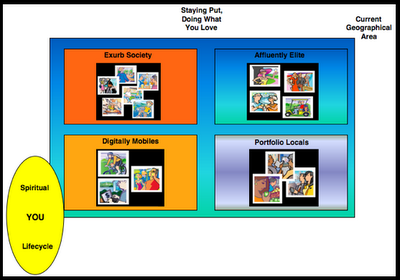
Live, Love, Work and Play in Four Wealthy Dream Communities
Chapter Four: The Tribal Territories
By Steve Howard, CKO
The Knowledge Labs
Table of Contents
Chapter One: Basecamp
Chapter Two: The Ridge
Chapter Three: The Outpost
Chapter Four: The Tribal Territories
“Wow! That’s the wrong guitar, I can’t do that. I’m trying to remember what key this is in. I put them down, it’s got big numbers and letters so I can see them, not that I’m like Grandpa. But who cares what chapter this is. Only people on the Internet. You people will have to get tapes of other shows, well I don’t have to talk to you directly, you’re not here. I’m trying to adapt to technology … 2K3, here we are.”
Neil Young & Crazy Horse “Greendale”
DOUBLE NICKEL RANCH. As communities and neighborhoods in them move slowly though their lifecycles, even the American Dream suburbs mature, become over developed or are over run with smog and congestion. Ever been stuck in traffic for an hour in the middle of Santa Barbara on the weekend?
Journal of 2020 Foresight: Describe the four sub-stories in the “Staying Put --Doing What You Love” scenario.
Eagle: For years in this scenario Boomers living in these neighborhoods – in the upper right hand corner where passion and local geographical area intersect --enjoyed the affluently elite American dream.
J2020F: In the Claritas PRIZM NE classification system, these neighborhoods are described as?
Eagle: As Uptown Urban and Elite Suburbs.
J2020F: How do you refer to them?
Eagle: Simply as “Affluently Elite.” It’s as if they’ve cornered a wealth-generating system. They find a safe haven for high margin income, pay for a high cost of living, accumulate peak real estate appreciation, and live in a secluded, secure and mature community.
J2020F: Why do I feel a “but” coming?
Eagle: But in their fifties, top executives and highly paid professionals fall victim to corporate restructuring, mergers and acquisitions.
J2020F: Unless they’re the ones doing the restructuring, merging and acquiring.
Eagle: And, realistically they’ve got employment contracts, so they won’t be running out of money any time soon. The bottom line? They have time to discover what they really want to do next.
J2020F: Still, they must have a high cash flow burn rate in these guarded exclusive enclaves.
Eagle: Yes, for those who choose to stay, the reality is that number of available slots at the top of the corporate towers become fewer and fewer.
J2020F: So, the time between like positions or advancements grows longer or requires relocation out of the area?
Eagle: If they've invested wisely, like most have, they may decide to move full time to their second homes in destination resorts, cash in all their equity, and manage their portfolio instead.
J2020F: So they assume the “Landed Gentry Role” and move to the destination resorts with the Wired-Less, Anywhere, Anytime crowd?
Eagle: Yes, primarily to the “Premier” or “Maturing Resorts” where they already own homes or plan to build a vacation or retirement home.
J2020F: What about for those second or third tier executives at the vice president or director level on shorter severance packages?
Eagle: You mean those not quite as wealthy but still affluent? They may have more options in diverse small and mid-size businesses.
J2020F: Yes.
Eagle: If they plan to stay in their current “destination” community – they explore options like pursuing top spots in smaller corporation – from a large cap publicly traded company to a mid cap or small cap – or like starting a business, buying a business, buying a franchise, or pursuing more entrepreneurial paths to generate income streams.
J2020F: And for those who are willing to move or take on projects out of the area?
Eagle: They discover how to build networks in different geographical locations while in the same location they work on higher margin projects doing what they love.
J2020F: On our “chess board” chart their story line moves them closer to the border with the “Wired-less folks.”
Eagle: That’s right. The square along the border adjacent to “Mature Resorts.”
J2020F: What label did you give to them? How does Claritas classify their neighborhoods?
Eagle: We simply call them, “Exurb Society.” Claritas singles out three lifestyles as “Second City Elite” , “Upward Bound” and “Gray Power” in their “Second City Society” and three of five (“Home Sweet Home” , “New Empty Nests” and “Beltway Boomers” ) “Affluential” lifestyles.
J2020F: And, the story for those one “chess square below”? Across from the “Distant Exurb” and above “Interim Middle Managers.”
Eagle: These are the consultants and professionals who first commute to, then relocate to, the exurbs to follow their clients as a way of building business in more preferred quality of life locations in emerging, mid- and late-growth locations.
J2020F: And, how do you describe them?
Eagle: “Digitally Mobiles.”
J2020F: And, in the Claritas scheme of things?
Eagle: Lifestyles primarily from three social clusters. Younger new media savvy business and lifestyles that include Up-And-Comers, from City Centers -- those twentysomethings with a “disproportionate number of recent college graduates who are into athletic activities, the latest technology and nightlife entertainment.”
J2020F: Others from the City Centers?
Eagle: No. Next are the Big Fish, Small Pond in the Landed Gentry. They’ve got upscale incomes and can afford to spend heavily on “consumer electronics, wireless and computer technology, luxury cars, powerboats, books and magazines, children's toys and exercise equipment.”
J2020F: And, the third?
Eagle: From 2nd City Society, are the Bright Lites, Li’l City. “They spend big on digital and wireless technology, business and cultural media, casual-dining restaurants, upscale retailers, foreign travel and luxury cars.”
J2020F: And, finally the last square?
Eagle: Yes, the forth category – we call “Portfolio Locals” --back to the right hand border just below “Affluently Elite” on the border just above “Starting Over”
J2020F: How does the story unfold for them?
Eagle: Typically they are just one step removed from being trapped in an unwanted interim occupation. While they can still afford the cost of living in maturing and slowly declining neighborhoods, the demand for fulfilling work they prefer drops.
J2020F: But, the volume of projects fills income gaps, so they are willing to take the tradeoff between staying in the same region they love?
Eagle: What they can’t earn in premium fees, they make up in smaller but high volume projects.
J2020F: Oh, and how does Claritas classify them?
Eagle: They tend to be found in the mix of Urban Midtown clusters, primarily in Urban Achiever and Multi-Culti Mosiac neighborhoods.
J2020F: So, if I'm considering all 16 options, how do you evaluate six types of real estate opportunities -- when to buy, how long to hold, and when to sell?
Got Knowledge?
Copyright ©2002 - 2006 Aarnaes Howard Associates. All rights reserved worldwide.
6:30 AM
Friday, July 28, 2006
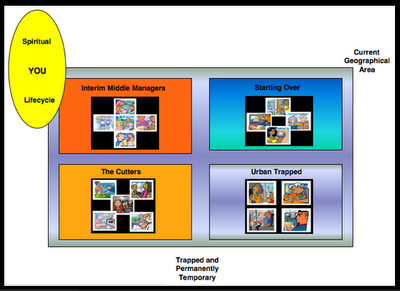
Interim Managers Starting Over with Trapped Urban Cutters
Chapter Four: The Tribal Territories
By Steve Howard, CKO
The Knowledge Labs
Table of Contents
Chapter One: Basecamp
Chapter Two: The Ridge
Chapter Three: The Outpost
Chapter Four: The Tribal Territories
“Earl, what a guy, huh? Well a lot of things are going on. Jed’s in jail. Sun doesn’t know what’s going on because Jed’s in jail and he used to be the youngest person in the family she could talk to … Now the media is out of control, I think we all know that. It’s nice to have them with us, but not always. They’re a little pushy, so they came to interview Grandpa about Jed. Because Jed killed a cop, of course they wanna do a special about that … Let’s find out what the Green family thinks.”
Neil Young & Crazy Horse “Greendale”
DOUBLE NICKEL RANCH. Of the four major future Baby Boom scenarios , the “Trapped and Permanently Temporary story lines take many by surprise. Unfortunately, these may be the future for many of the older brothers and sisters who are forced into retirement too soon.
J2020F: How would you describe the four trapped and permanently temporary sub-categories?
Eagle: They find themselves struggling to make ends meet searching for projects or assignments in high cost-of-living communities.
J2020F: While these stories may describe a growing percentage of Boomers in the last decades of their lives, what about for those past their prime in their 50s?
Eagle: You’re talking about the ones who run up against “age discrimination.” Those who still want to practice what they love doing where they once enjoyed living.
J2020F: Right. The ones who find that the demand for their services on a full time basis and at the salary they had been accustomed to is next to impossible.
Eagle: One scenario, in the extreme, takes place when their major employers leave a once thriving community and property values decline.
J2020F: Can you give me some examples?
Eagle: Let’s start with the lower right hand corner, what we’re now calling the “Urban Trapped” In the Claritas PRIZM NE classification system, most of the lifestyles belong to the lowest social and economic classes. It includes among others Urban Elders – located in the downtown urban neighborhoods of big cities and City Roots -- lower-income retirees, typically living in older homes and duplexes they've owned for years. In these ethnically diverse neighborhoods life is often an economic struggle for old and young singles and single-parent families facing enormous challenges: low incomes, uncertain jobs and modest educations.
J2020F: It would seem options are limited.
Eagle: Well, as you can imagine, those with strong roots in the community can't afford to move to a newer neighborhood in the same community as their neighborhood declines.
J2020F: And, if with less demand for skills they’ve developed over the years in their community, if they stay too long they’ll find themselves owning property that is worth only a fraction of what it once was.
Eagle: Yes that’s right. They’re value in the labor market drops, so they’re in a bind – even when what they do is something they hate doing just to make ends meet.
J2020F: What are they to do?
Eagle: They can “move” in three directions on our chart – up towards the border along the “Staying Put, Doing What You Love” scenarios, or to the left towards the border with the “Struggling Lone Eagle, Over Priced for Local Market” stories, or diagonally from right to left towards the center close to the “It’s Wired-Less – Doing What You Love, Anytime and Anywhere” scenario.
J2020F: How about the first one?
Eagle: Heading “north, but still most likely to stay in the same geographical neighborhood” if they can land something?
J2020F: Yes.
Eagle: We call this sub-group the “Starting Over” closest to Claritas PRIZM NE’s Inner Suburbs.
J2020F: Which segments fit the best from their scheme?
Eagle: Because the people in the neighborhoods tend to concentrate in the “inner-ring suburbs – areas where residents tend to be high school educated, unmarried and lower-middle class -- you find adults in transition and twenty-something singles and couples just starting out on their career paths –or starting over after recent divorces or company transfers.
J2020F: Talking about company transfers, I’m guessing you bump into more downsized suburban retirees, right?
Eagle: Yes. Claritas calls them the Old Glories and the American Classics who age in place in older apartment complexes, but their neighborhoods also include others with eclectic lifestyles.
J2020F: Eclectic lifestyles?
Eagle: Yes, Claritas calls them Suburban Pioneers – “a mix of young singles, recently divorced and single parents who have moved into older, inner-ring suburbs. They live in aging homes and garden-style apartment buildings, where the jobs are blue-collar and the money is tight.”
J2020F: It is dawning on me that this whole scenario “Trapped and Permanently Temporary” is all about “fight or flight.”
Eagle: Well, summarized. I would only add it is also about having the resources to do either.
J2020F: So, let’s talk about flight, along the bottom and to the left towards the Rustic and Country Eagles.
Eagle: No pun intended?
J2020F: None worth mentioning.
Eagle: Would the “Hotel California” fit in their flight plans?
J2020F: Enough’s enough, already. What do you call the sub-story bordering the “Rural Country” communities?
Eagle: We’ve named them “The Cutters” after the townies and their families in the Little 500 cycling movie – “Breaking Away,” starring a young Dennis Quaid.
J2020F: Oh yeah, right. They live in a college town and are often getting into fights with some of the male college students.
Eagle: While Claritas describes them as “Micro-City Blues” -- downscale residents living in the affordable housing found throughout the nation's smaller cities -- it was the high concentration of twentysomethings that caught our attention.
J2020F: So this the social tribe crowd who hang out together before marriage – like “Friends?”
Eagle: Not exclusively. In addition to the two Gen Y segments – “City Startups” and “Mobility Blues” , you’ve got “Park Bench Seniors” and “Hometown Retired” too.
J2020F: Don’t forget the last segment, “Family Thifts” and you’ve got quite a diverse neigborhood.
Eagle: You’ve got quite a mix. Claritas describes the neighborhoods as being “filled with cheap apartments and a commercial base of cafés, bars, laundromats and clubs that cater to twentysomethings.”
J2020: These stories take place in communities that haven’t declined as much – around universities – compared to “Urban Trapped” neighborhoods.
Eagle: That’s true. In fact, for investors and landlords there is potential for some income from real estate rehabilitation projects in some of these neighborhoods.
J2020F: So the cost of living is lower.
Eagle: And, the quality of life – while not the best – is better than the urban blight and congestion found in the former neighborhood.
J2020F: The last “chess move from the lower right “Urban Trapped” corner is diagonally up and to the left towards the mid-point intersection of all four major quadrants.
Eagle: I believe that sub-story is the most versatile in a way. We named it “Interim Middle Managers”
J2020F: Why?
Eagle: Because in the Claritas scheme of things, it takes on some characteristics of neighborhoods in the “Middle America” cluster and others in the “Middle Burbs”.
J2020F: O.K. I get the middle, but why the interim manager name?
Eagle: This is the story about those who can secure an occasional long-term assignment. They begin to master the forced entrepreneurial style with free-lance assignments taking advantage of tax write-offs.
J2020F: But worry about health insurance and longer-term security?
Eagle: Yes. Moving towards the center, they return to school or find projects – both paying and non-paying -- on which they can “fake it until they make it” to develop higher margin skills to replace the ones that had become obsolete.
J2020F: So, they eventually find higher paying projects out of the area that lead to temporary assignments and the potential for moving to a better quality of life location.
Eagle: For some they find they can translate skills they've mastered in one industry to another one in higher demand.
J2020F: This is the path of customization and personalization, right?
Eagle: Yes, that’s right. A path to offering premium products or services to more affluent customers and clients willing to pay for the higher standard of service and experience.
J2020F: Clients or customers along the top rows of both the of the Wired-Less” and “Staying Put” communities, right?
Eagle: Exactly.
J2020F: What’s next when you’ve been used to living, loving, working and playing in communities that everyone else can only dream about?
Got Knowledge?
Copyright ©2002 - 2006 Aarnaes Howard Associates. All rights reserved worldwide.
6:55 AM
Thursday, July 27, 2006
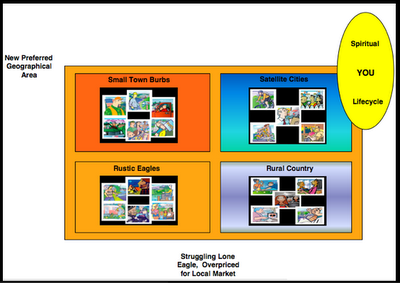
Vacation Lifestyles in Pristine Communities
Chapter Four: The Tribal Territories
By Steve Howard, CKO
The Knowledge Labs
Table of Contents
Chapter One: Basecamp
Chapter Two: The Ridge
Chapter Three: The Outpost
Chapter Four: The Tribal Territories
“I tell you all this because you can’t tell by listening to the songs, you have to listen to the instrumentals to get this. Anyway, so when you see somebody like Eric Clapton up there playing guitar and closing his eyes it could be anything. It could be anything.”
Neil Young & Crazy Horse “Greendale”
DOUBLE NICKEL RANCH. With the right knowledge products producing multiple streams of residual income, Struggling Lone Eagles overcome their challenge of making it in rural local markets. As with the four wireless resort communities, Rustic Eagles live in four kinds of neighborhoods, as well.
Journal of 2020 Foresight: The four sub-stories in this scenario – the bottom left “quadrant” in the original model -- share an entrepreneurial and self-sufficient combination that distinguishes them from the other scenarios, right?
Eagle: And, they share a determination to find towns where they can enjoy a higher quality of life – beyond the mid-point for preferred location. But unlike the “Wired-Less Landed Gentry,” these residents traded off what they really dreamed about doing – since the whole quadrant falls just below the mid-point – for the privilege of living a “vacation” lifestyle.
J2020F: Since Rustic Eagle communities lie off the beaten path, I imagine quite often the local community is too small or too dispersed to charge higher margin services to the local demand.
Eagle. Yes. Except for the Eagles bordering the “Wired-Less” boundary – just below the “Resort Suburbs” and “Distant Exurbs” in Small Town Burbs and Satellite Cities.
J2020F: By that, you mean, what?
Eagle: I mean the story takes place in the highest quality of life community on the outskirts of some of the more famous destination or maturing resorts.
J2020F: So, that would mean living not too far from destination resorts provides a client base.
Eagle: Right. And, the lower cost of living allows them to build their reputation more slowly and afford to charge less for their services to build their business or consulting practice – wired or not.
J2020F: They enjoy these communities with more affordable living costs while they're living at a greater distance than the two sub- quadrants “across the Wired-Less and Eagle border” closer to the destination resort towns. Describe each of the four stories in a little more detail.
Eagle: Still finding enough projects to support what they love to do the “Struggling Lone Eagles” in exurbs of the urban and suburban centers are found in maturing communities with slightly declining quality of life.
J2020F: These are the ones who “border” the “Staying Put” scenario?
Eagle: Yes. Eagle citizens of “Satellite Cities” are just a little country, but mostly “citified,” if there is such a word.
J2020F: They don’t live in the more remote or rural areas?
Eagle: They’re more of a mix of old and young, homeowners and renters, families and singles– who live in satellite cities – as opposed to large metropolitan urban centers.
J2020F: But in terms of lifestyle, they enjoy leisure and recreation pursuits with a lower cost of living and more relaxed pace?
Eagle: Yes. While they can afford to find clients and customers more slowly in a preferred location, they have little trouble maintaining their workload with current clients.
J2020F: What motivates them?
Eagle: For the restless eagles, this may not be their final destination. Their major challenge is creating demand for their services in a more affluent resort community to which they want to relocate -- either for what the community offers or for the income.
J2020F: So, the two sub-stories, both close to the border separating them from the Wired-Less and Staying Put scenarios play out in average passionate or average quality of life communities?
Eagle: Yes. Except for natives of “Small Town Burbs” who enjoy an above average quality of life. These are communities of small families and empty-nesting couples. “They live a rustic lifestyle where hunting and fishing remain prime leisure activities along with cooking, sewing, camping and boating,” according to Claritas PRIZM NE.
J2020F: Now what about the “bottom two” neighborhoods – “Rustic Eagles” and “Rural Country”?
Eagle: The last two scenarios describe people who really don't enjoy what they have to do to support their lifestyle in a place that offers more for less.
J2020F: I take it that those who live in pristine, but rustic places may eventually make a killing in real estate appreciation, but investing in the community solely for a financial gain is more risky and may take longer, right?
Eagle: Exactly. The benefit is the lower price of land and a better quality of life tied to shared community values with more of an emphasis on self-sufficiency.
J2020F: I take it just from their names that Rustic Eagles may be the most isolated – living on the back roads?
Eagle: They’re most “extreme scenario” story -- where quality of life communities are the furthest from resort destinations and involve vocations that Lone Eagles hate – is all about extreme self-sufficiency.
J2020F: What my friend would call living off the grid. And that leaves …
Eagle: The last subcategory of “Rural Country Eagles” is really a community for “Trapped and Permanently Temporary” workers from “across the border to the right” searching for a much lower cost of living in a relatively higher quality of life town.
J2020F: By virtue of their new living quarters, they work on low margin projects in unfulfilling jobs?
Eagle: That’s right. They have longer than average commutes and may have to follow the work on extended stays for the tradeoff to a better quality of life. They might end up living off the grid in Rustic Eagle neighborhoods.
J2020F: Is it a better option than the future for too many of the generation’s older brothers and sisters who are forced into retirement earlier than anticipated?
Got Knowledge?
Copyright ©2002 - 2006 Aarnaes Howard Associates. All rights reserved worldwide.
9:52 AM
Wednesday, July 26, 2006
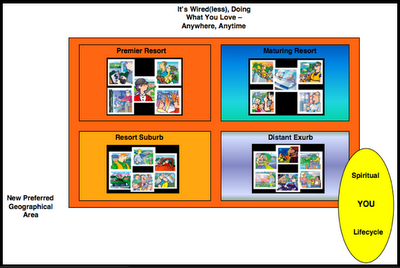
Moving to Wireless Premier, Maturing, Suburban or Exurban Resorts
Chapter Four: The Tribal Territories
By Steve Howard, CKO
The Knowledge Labs
Table of Contents
Chapter One: Basecamp
Chapter Two: The Ridge
Chapter Three: The Outpost
Chapter Four: The Tribal Territories
“And he’s going ‘I’ve never painted anything like this before,’ so he took it to the gallery to see what would happen and Lenore, who runs the gallery, she loved it. She loved this painting. She hung it in the most prominent place in the gallery and told Earl to bring in anything he painted and that she would love to have it. It was the most fantastic thing that ever happened to Earl, and he couldn’t figure it out, but what the heck, huh? Got a painting in there now …”
Neil Young & Crazy Horse “Greendale”
DOUBLE NICKEL RANCH. Within the Wired-less Doing What You Love – Anywhere, Anytime “box” we find four sub-stories. Imagine a premier resort location – say Lake Tahoe – it isn’t hard to imagine slightly less affluent neighborhoods in lower cost of living zip codes radiating out from the ski areas.
Journal of 2020 Foresight: Explain the four sub stories. What do Boomers need to know about them? Do they exist only in this scenario? Or are there, in fact, a total of 16 sub stories?
Eagle: O.K. One may lead to a better fit compared to the other three. No. Yes.
J2020F: Do go on, wise guy.
Eagle: When you look at the four-box model, you notice that the names of the four major scenarios sit in the extreme corners.
J2020F: So Wired-less Doing What You Love -- Anywhere, Anytime sits just outside of where two extreme points come together.
Eagle: We did that on purpose. In this case the name sits on the intersection of the best in passion – doing what you love, and the best in a preferred geographical location.
J2020F: So if we divided each of the four scenarios into four sub-boxes, we’d be able to show, what?
Eagle: While each of the four all fit the definition of “Doing What You Love in your New Preferred Geographical Area” each varies in relation to degrees of doing what you love and degrees of quality of life offerings.
J2020F: So the two on the right side – that border “Staying Put, Doing What I Love”might be interpreted as less preferable on quality of life dimensions?
Eagle: Yes, they share that story. But the difference between the two is the upper box affords the best in terms of passion compared to the box just below it – the one that “touches” the “Trapped and Permanently Temporary” box to the lower right at the intersection. Does that make sense?
J2020F: I think so. We accounted for the lower box, what about the box to it’s left just below the best passion and best location?
Eagle: We say that since it borders like the “trapped combination” on the upper boundary between the “Struggling Lone Eagle, Overpriced for the Local Market” scenario and the “Wired-less scenario” that it shares the best quality of life community, but just above average in passion or fulfillment.
J2020F: O.K. I think I’m starting to get it. Each quadrant has an extreme box in each of the four corners.
Eagle: And each scenario has three other boxes that border the other three scenarios. If the boxes were towns, they’d surround Lake Tahoe, for example – some being closer to the Lake, others lying at some distance from it.
J2020F: So, you could predict that they share some common “real estate story” near their common borders?
Eagle: That’s right. The extreme, in this case “It’s Wired(less), Doing What You Love – Anywhere, Anytime” the best in both horizontal and vertical dimensions (passion and quality of life), community more often than not is a resort town offering premier lifestyles. The clientele demands tailored services -- high margin and personalized.
J2020F: You expect to find the more affluent lifestyle neighborhoods, right?
Eagle: Yes, and you do. In the Claritas scheme of things these are the Landed Gentry communities -- Country Squires and God's Country neighborhoods.
J2020F: What about dropping down to the border shared with the “Struggling Lone Eagles, Over-Priced for What Local Markets?
Eagle: On the outskirts of the new and growing premier resort communities, doing more of what they love are the wired-less struggling eagles who enjoy the lifestyle advantages, have traded-off their passionate work for quality of life, but have enjoyed moderate to high rates of real estate appreciation.
J2020F: O.K. Let’s see if I get this. These are some of the less affluent, but educated neighborhoods, right?
Eagle: Yes. You'd expect to find a combination of lifestyle neighborhoods from Big Fish in Small Pond in the Landed Gentry cluster and Greenbelt (Families) and Big Sky families (now) of the Country Comfort and New Homesteaders (former New Eco-topia) of the Country (Families) Comfort social clusters.
J2020F: O.K. this time let’s move to communities on the same level, but to the right. Describe the upper box that sits between our new and growing premier resort communities and the Staying Put, Doing What I Love scenario stories.
Eagle: Some of the aging resort towns -- similar to maturing Staying Put communities (on the other side of the “border”), you find that a combination of a maturing quality of life with high degrees of past real estate appreciation.
J2020F: When you look at the zip codes, what types of neighborhoods would you find?
Eagle: A mix between two affluent tribal clusters -- the Second City Society and some of the lifestyle profiles from The Country Comforts.
J2020F: So these communities remain content and aren’t taking steps to revitalize themselves?
Eagle: Yes that may very well be the case. But if they do upgrade, what with the cost of living and newer developments increasing real estate prices, many of the earlier residents could no longer afford the resort lifestyle.
J2020F: So entrepreneurs begin to notice that their higher margin services are sought out by fewer and fewer clients, and that pattern translates into increasing travel and commuting costs.
Eagle: True. So they cut back on costs or find other ways to make it work for them. On our chart, they can move to the left and down to become a combination “Wireless – Lone Eagle” or drop straight down and become a “Wireless- Temporary.”
J2020F: Dropping straight down is the last of the three sub-stories. What is it like?
Eagle: While still a preferred lifestyle location the wired-less, but permanently temporary communities attract the remaining lifestyles in the social clusters – Crossroads Villagers (similar to the former River City, USA) in the Rustic Living cluster and Shotguns and Pickups and Red, White & Blues in the Middle America, and the New Homesteaders of the Country Comfort (former Exurban Blues).
J2020F: What do they have in common?
Eagle: Moving to these neighborhoods is a difficult transition. While not working on projects that they hate, it is difficult to dig yourself out of a financial hole, since most of the work is on low margin projects. The unfulfilling work, long commutes, and extended stays represent tradeoffs for a slightly better quality of life.
J2020F: Is a more rustic vacation lifestyle a better option?
Got Knowledge?
Copyright ©2002 - 2006 Aarnaes Howard Associates. All rights reserved worldwide.
7:30 AM
Tuesday, July 25, 2006
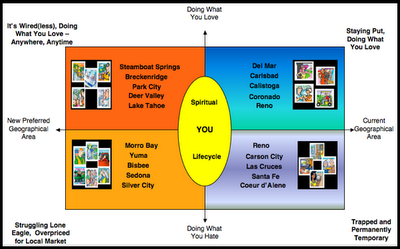
Finding Your Best Fit: Healthy, Wealthy and Wise Choices
Chapter Four: The Tribal Territories
By Steve Howard, CKO
The Knowledge Labs
Table of Contents
Chapter One: Basecamp
Chapter Two: The Ridge
Chapter Three: The Outpost
Chapter Four: The Tribal Territories
“He was always getting turned down. When the Devil cleaned Earl’s glasses he laid them down there by the easel and he left. Then Earl came in the next day, put on his glasses and started painting stuff he’d never painted before. Suddenly, he was painting this picture of this guy in a red suit with red shoes and kind of a Panama hat with a red hatband on it, holding a sign that said ‘Alaska’ on it, like he was hitchhiking.”
Neil Young & Crazy Horse “Greendale”
DOUBLE NICKEL RANCH. Examples abound across the western region of the United States for each of the four Baby Boomer futures.
Journal of 2020 Foresight: How about some examples of locations fitting each scenario throughout the West?
Eagle: You'll find “Staying Put, Doing What You Love” neighborhoods in California: in late growth Del Mar and coastal exurb Carlsbad (the Winner's Circle and Executive Suite lifestyles of the Elite Suburbs the Affluentials social group), in early maturity Calistoga (also Winner's Circle and Gray Power which got reclassified from the Second City Society to Middleburbs) and on the San Diego Coast in Coronado -- at the San Diego’s urban gold coast – with Money and Brains and the Young Literati lifestyles of the Urban Uptown social clusters.
J2020F: Anywhere else?
Eagle: A lot of our Boomer friends like Nevada.
J2020F: O.K. What’s in Nevada?
Eagle: As if you didn’t already know. You'll find the Elite Suburbs again (Winner's Circle) The Affluentials again (Executive Suites, Pools and Patios and Kids & Cul-de-Sacs) in late maturity Reno together with two Second City Society, two more Affluentials and five Second City Centers, now simply known as City Centers, lifestyle neighborhoods according to multiple zip codes.
J2020F: Where do you go if you are a Struggling Lone Eagle?
Eagle: I go home.
J2020F: I meant ….
Eagle: I know what you meant. You look for the Working Towns in our original research (reclassified as Middle America), Heartlanders (Middle America) and Rustic Living communities. In California you might choose maturing growth Morro Bay ( Golden Ponds and Old Milltowns lifestyles in the Rustic Living clusters and (now a lifestyle segment) Heartlanders in Middle America Blue Highway and Back Country Folk neighborhoods in the Rustic Living cluster.
J2020F: How about in the Southwest – say Arizona or New Mexico?
Eagle: If you like Arizona -- then consider emerging growth Yuma, maturing growth Sedona and innovation Bisbee.
J2020F: And New Mexico?
Eagle: In New Mexico, check out innovation Silver City, Angel Fire and Ruidoso or emerging growth Las Cruces, maturing growth Taos or late maturity Santa Fe.
J2020F: In Colorado?
Eagle: How about innovation Pagosa Springs, the emerging growth towns of Durango, Minturn and Red Cliff or the maturing growth communities of Telluride, Steamboat Springs, Glenwood Springs or Crested Butte.
J2020F: Utah?
Eagle: In Utah -- the innovation towns of Moab, Boulder and Escalante.
J2020F: How about a different scenario? Say the Trapped and Permanently Temporary scenario?
Eagle: Here’s where we’re doing some updating. Our original research classified neighborhoods based on the previous Claritas PRIZM categories.
J2020F: O.K. What do you have today?
Eagle: Towns that might fit the “Trapped and Permanently Temporary” scenario include Urban Cores, Micro-City Blues, (many of the former Second City Blues cluster) and Inner Suburbs.
J2020F: How many towns in the West pop up the most?
Eagle: Across the west the three more popular lifestyles belong to the former Second City Blues Cluster. They include Smalltown Downtown -- 10 towns, Family Scramble -- 10 towns, and Hometown Retired. Many of these have been updated and reclassified by Claritas to Micro-City Blues.
J2020F: So, these are the most frequent – Smalltown Downtown and Family Scramble? Give us some examples.
Eagle: You'll find those Nevada neighborhoods in medium growth Carson City and late maturing Reno; in New Mexico in emerging growth Las Cruces and late maturity Santa Fe; and in Idaho in medium growth Coeur d'Alene and early growth Bend, Oregon.
J2020F: If I get this straight, while these towns may differ in climate and recreation, the one thing they have in common is a social group and lifestyle profile that cuts across different states.
Eagle: Right. If the Smalltown Downtown lifestyle profile found in the Second City Blues Cluster fits you, then chances are the towns I just named would be a better fit for you than any others you might be considering.
J2020F: Armed with this insight about me and about these neighborhoods, I’d want to compare them on other factors that are important to me.
Eagle: That’s right. But, according to the “Birds-of-a-Feather-Flock-Together” principle, you’ll find more happiness concentrating on a short-list that matches your profile.
J2020F: Great. Well, I’m really interested in finding out more about the “Wired-Less Love” scenario. What about the three core tribal clusters populating that scenario – the Landed Gentry, Country Comfort (Families) and some of the Middle America (former Exurban Blues)?
Eagle: How about in Nevada, Colorado or Utah?
J2020F: I’m all ears!
Eagle: First in Nevada, you'll find Country Squires (of the Landed Gentry) in emerging growth Elko, maturing growth Carson City, late maturity Reno and late maturity Tahoe / Inclined Village.
J2020F: Where in Colorado?
Eagle: In early growth Minturn and Red Cliff, in medium growth Steamboat Springs and Beaver Creek and three late maturity towns -- Breckenridge, Boulder and Snowmass.
J2020F: Just as I expected. What about Utah?
Eagle: You probably won’t be surprised to learn they show up in late maturity towns of Park City and Deer Valley and Sun Valley in Idaho.
J2020F: If you’re looking for a vacation or second home in a resort community, how can you compare tradeoffs
Got Knowledge?
Copyright ©2002 - 2006 Aarnaes Howard Associates. All rights reserved worldwide.
7:10 AM
Monday, July 24, 2006
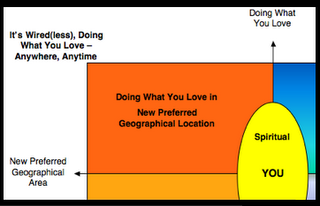
Landed Gentry: Wired to Live, Love, Work and Play Anywhere You Want
Chapter Four: The Tribal Territories
By Steve Howard, CKO
The Knowledge Labs
Table of Contents
Chapter One: Basecamp
Chapter Two: The Ridge
Chapter Three: The Outpost
Chapter Four: The Tribal Territories
“Earl was a painter and a Vietnam Vet. There’s a lot of those. He specialized in psychedelic paintings. He painted a lot. Sun used to love to watch him. He was not a very successful painter and never did sell anything, but he always tried. He took them to Gallery L on Main Street. Lenore was the owner of the Gallery.”
Neil Young & Crazy Horse “Greendale”
DOUBLE NICKEL RANCH. Of the four futures, this story is similar to the “Staying Put” scenario because both allow Boomers in their 50s to do what they love. The Wired Landed Gentry also shares the love of a new quality-of-life community with the “Rustic Lone Eagles."
Journal of 2020 Foresight: How has this scenario fared over time?
Eagle: Well this has always been the best of both worlds and the model for what we’ve come to call Mobile KnowCos based upon the convergence of the trends we already talked about.
J2020F: You modified it though, right?
Eagle: Remember, we coined the combination of doing what you love in your preferred geographical area during the time of dial-up Internet connections.
J2020F: So, that would account for “It’s Wired, Doing What You Love -- Anywhere Anytime.
Eagle: But now the freedom of the digital wireless connections available today made us update the name to Wireless. We still believe collaborative tools and networks bring together project teams of experts from around the globe on behalf of an enterprise. With the ability to operate anywhere there is a" wired" infrastructure, the boomers began their move to smaller towns and rural regions, the “penturbia migration.”
J2020F: Name for us, as you have for the other three scenarios, the types of Claritas social groups we’d expect to find in communities fitting this scenario.
Eagle: You’ll find Landed Gentry, Country Families (now Country Comfort), and some 2nd City Societytribal social groups in the Wired-less Doing What You Love Anywhere communities since we’ve observed that this scenario presents high-demand, high margin entrepreneurial opportunities.
J2020F: Where will I find these communities -- all four kinds?
Got Knowledge?
Copyright ©2002 - 2006 Aarnaes Howard Associates. All rights reserved worldwide.
1:19 PM
Sunday, July 23, 2006
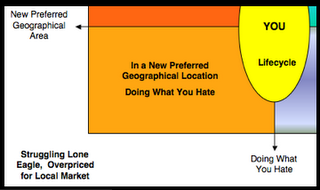
Rustic Eagles: Country Comfortable and Rocky Mountain High
Chapter Four: The Tribal Territories
By Steve Howard, CKO
The Knowledge Labs
Table of Contents
Chapter One: Basecamp
Chapter Two: The Ridge
Chapter Three: The Outpost
Chapter Four: The Tribal Territories
“When the instrumental happens there at the end when I was playing the guitar, the devil went to Earl’s studio. He went to his studio and materialized there and cleaned Earl’s glasses. He cleaned his glasses.”
Neil Young & Crazy Horse “Greendale”
DOUBLE NICKEL RANCH. While the motivation may be similar to “Trapped and Permanently Temporary” – a layoff or some other event -- Baby Boomers in their 50s, or anyone else for that matter , leave the region for a less expensive and a more self-sufficient lifestyle.
Journal of 2020 Foresight: So this is your scenario. The Struggling Lone Eagle, Overpriced for Local Market,
Eagle: Yes. And it has changed over the years, too.
J2020F: In what ways?
Eagle: For one, real estate appreciation drove speculation that drove up real estate prices.
J2020F: So, if you weren’t already a homeowner with a primary residence in the area, it became too late?
Eagle: Even vacation or second homes. And, we experienced a backlash.
J2020F: How is that?
Eagle: That whole outsiders-versus-community-insiders tension. And, for good reason. Old timers quickly realized with property values approaching the stratosphere, their children who grew up in their communities would never be able to own a home, should they want to stay.
J2020F: This is the phenomenon you talked about earlier – fit. What seemed like the perfect career or lifestyle move turns out to be a chapter from the feud between Hatfields and the McCoys?
Eagle: And, another change -- one of the primary Claritas PRIZM groups – New Eco-topia disappeared from their lifestyle and social cluster system.
J2020F: Why?
Eagle: I believe it reflects a drop in the opportunities for primarily professional high-technology workers to have it all -- a good paying job and a rustic lifestyle. But, I don’t know.
J2020F: We passed near a few towns on our road trip that were home to New Eco-topia neighborhoods. We talked about two of them when we stayed in Las Vegas – Minden and Gardnerville outside of Lake Tahoe.
Eagle: I first discovered it when we met for coffee at that Starbucks in Lake Tahoe.
J2020F: Wait a minute. I seem to recall a conversation about some clues Grey Owl had sent us – where were we? Still in Cabo San Lucas?
Eagle: Oh, yes. You’re right. We found out both Durango and Pagosa Springs were home to New Eco-topia neighborhoods.
J2020F: And we even reviewed some others -- Big Bear in California, and in Telluride near Durango, Colorado and both Steamboat Springs and Glenwood Springs.
Eagle: Right again. We illustrated how you could take zip codes for Dana Point in California and Austin, Texas and then discover other communities in the West that matched the attractive lifestyle elements.
J2020F: And, not to be stickler for accuracy, but …
Eagle: I know. The first time any of us talked about it was when we discussed how to do what you love, by following referrals and introductions to the kinds of towns that matched your quality of life preferences.
J2020F: Looking for a better quality of life and a more affordable cost of living Lone Eagles migrate to …
Eagle: To neighborhoods known as the T2 Country Comforts (former R1 Country Families – New Eco-topias) Middle America , (formerly known as T3 Working Towns and R2 Heartlanders), the Rustic Living neighborhoods.
J2020F: What about the last of the four scenarios, the Wireless Landed Gentry?
Got Knowledge?
Copyright ©2002 - 2006 Aarnaes Howard Associates. All rights reserved worldwide.
7:28 AM
Saturday, July 22, 2006
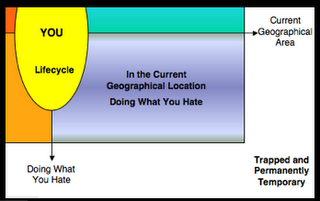
“I Used To Be Somebody, Damn It!” -- Trapped and Permanently Temporary
Chapter Four: The Tribal Territories
By Steve Howard, CKO
The Knowledge Labs
Table of Contents
Chapter One: Basecamp
Chapter Two: The Ridge
Chapter Three: The Outpost
Chapter Four: The Tribal Territories
“This song has to do with Earl Green, Sun Green’s father; Edith Green’s husband, Jed Green’s uncle (Jed the cop killer). Earl’s an artist. He’s always painting these beautiful paintings… and Earl hardly ever sells a painting…. So he’s traveling around. He’s got money problems and he likes to go in his camper; he’s got a Winnebago, like a camper you live and drive around and he drives around to different galleries with his paintings in his Winnebago, goes in to people and tries to get something happening. One night he stopped in a motel. He had a few personal moments with the computer and television set….”
Neil Young & Crazy Horse “Greendale”
DOUBLE NICKEL RANCH. There’s a dark side to “Staying Put” too long, especially, if your community matures and begins to decline. Or, your employer relocates to another town or city. If your region hasn’t diversified in the industries it supports, and if a sector like manufacturing finds it too difficult to compete and leaves for less expensive communities , then your specialty may no longer be marketable in your hometown.
Journal of 2020 Foresight: I take it that as you cross a threshold, directly below and to the right in your “4-Box Model, to the Trapped and Permanently Temporary scenario....
Eagle: The scenario headline gives it away, doesn’t it. The story describes families forced to do what they dislike just to make ends meet.
J2020F: Trailblazer would be proud. You can guess what this one is about, and that adds to its believability factor.
Eagle: We originally conceived this scenario occurring during recessions to 50 year olds who once commanded a big salary for work that has been outsourced.
J2020F: I know some of these people. They used to jokingly refer to themselves as, “I Used To Be Somebody!”
Eagle: But, now we see growing evidence that this may be the destination for Baby Boomers who hadn’t saved enough, didn’t inherit enough, and rented or lost their homes due to foreclosures. They’re looking for more affordable lifestyles while downsizing their expectations.
J2020F: And, this may also be the scenario for many who choose to consult without benefits, although if they had their way they’d find a good paying full-time job to replenish their nest egg.
Eagle: Yes. In the meantime, they can only offer an unmarketable or commodity-priced expertise in the community that they once could afford. If they choose to stay in the same general region, they fit the post-maturity and declining – but perhaps more affordable U3 Urban Core, C3 Second City Blues (now Micro City Blues) and S4 Inner Suburb tribal social clusters.
J2020F: What about leaving the region for a less expensive and a more self-sufficient lifestyle?
Got Knowledge?
Copyright ©2002 - 2006 Aarnaes Howard Associates. All rights reserved worldwide.
6:34 AM
Friday, July 21, 2006
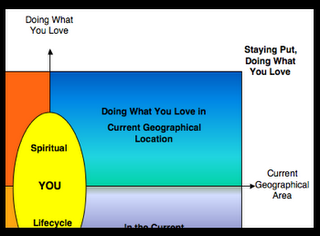
Affluently Elite Neighborhood Secrets: What Do They Know, That I Don’t?
Chapter Four: The Tribal Territories
By Steve Howard, CKO
The Knowledge Labs
Table of Contents
Chapter One: Basecamp
Chapter Two: The Ridge
Chapter Three: The Outpost
Chapter Four: The Tribal Territories
“What about the wreckage of murder? It’s terrible. Jed killed a cop, and that’s a bummer right there, because Carmichael … Officer Carmichael … had a family, he had friends. He had a beautiful wife. Officer Carmichael is no longer on the planet. Some people think that police are evil and hippies are good, but it may not be true. There’s a gray area. He didn’t have any kids, but he did have a nice group of friends, all the other officers who worked with him.”
Neil Young & Crazy Horse “Greendale”
DOUBLE NICKEL RANCH. Two of the four scenarios for Baby Boomers in their 50s, have location in common, but they differ on the dimension of doing what they love.
Journal of 2020 Foresight: Residents most likely to be doing what they love, and who plan to stay put for the foreseeable future can be found, where?
Eagle: On our chart it is in the upper right hand corner at the intersection of “Doing What You Love in Current Geographical Location”
J2020F: This scenario describes neighborhoods that still provide a high degree of quality of life – but, in some areas, the neighborhoods approach maturity and begin to decline?
Eagle: Yes. Typically, you'll find the more affluent U1 Urban Uptown and S1 Elite Suburbs in the better neighborhoods and the C1 Second City Society, S2 the Affluentials and U2 Urban Midscale (now renamed as Midtown Mix) “social tribes” populating the maturing neighborhoods.
J2020F: We visited some of these neighborhoods in Parker, Colorado to which our friend moved from an exclusive Chicago suburb.
Eagle: Exactly, they don’t have to live in congested, urban areas so you find like-minded residents in the elite suburbs. Statistically, these neighborhoods house a high concentration of the wealthiest in the United States. If you are familiar with the Southern California – you’d find them in La Jolla, Torrey Pines, and Escondido (San Diego County) and Newport Coast, Newport Beach, Corona del Mar, Huntington Beach, Irvine and Mission Viejo (Orange County).
J2020F: But, there’s a dark side to “Staying Put” too long, especially, if your community matures and begins to decline.
Got Knowledge?
Copyright ©2002 - 2006 Aarnaes Howard Associates. All rights reserved worldwide.
7:24 AM
Thursday, July 20, 2006
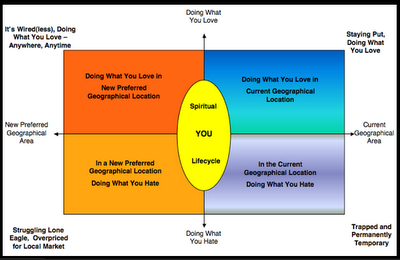
Staking Your Claim: Four Corners for Thinking Inside the Box
Chapter Four: The Tribal Territories
By Steve Howard, CKO
The Knowledge Labs
Table of Contents
Chapter One: Basecamp
Chapter Two: The Ridge
Chapter Three: The Outpost
Chapter Four: The Tribal Territories
“On the very edge of Greendale, about a hundred yards from that sign that says ‘Leaving Greendale,’ there is a big billboard put up by the Greendale Chamber of Commerce. That’s where Officer Carmichael parked his police cruiser on that fateful day…. So Jed went to Jail. He’s in jail. He screwed up. He’s had it. I don’t think they’re gonna get him. I took note of that comment over there. This is a test. I don’t know if I’m gonna pass it or not. Someday, maybe today, but for a minute I’d like to stay in Greendale because Jed’s in jail, okay.”
Neil Young & Crazy Horse “Greendale”
DOUBLE NICKEL RANCH. The “Passion and Place” scenarios boil down to doing what you love or hate in the same or different community. Simple on the surface, but gut wrenching below the surface -- if conditions change.
Journal of 2020 Foresight: So looking at the Boomers’ next chapter in their lives, these four scenarios help them, in what way?
Eagle: Over the years the scenarios evolved to a focus on fit.
J2020F: Fit? In what way?
Eagle: Finding a new, or remaining in, the right quality-of-life community that fit cherished lifestyle preferences and provided different degrees of real estate appreciation. I can’t tell you how many people I know who moved from Southern California to what they thought would be a great life in a rural community, only to return.
J2020F: I imagine what you’ve uncovered extends beyond Boomers to their families at different life stages, as well?
Eagle: That’s right. In fact in April of 2006 Century 21 published a press release that detailed differences in real estate buying habits among the generations – Boomers and their maturing children.
J2020F: In the beginning how did the scenarios add value?
Eagle: Opening up opportunities that didn’t exist before. We identified the convergence of technology and migration patterns that allowed somebody with an expertise to work in a community without a local customer base.
J2020F: And in their current evolution?
Eagle: We’ve constructed a knowledge base that matches sixteen sub-classifications – four each for each of the four scenarios – to resort communities and now, we’re opening up eight other categories.
J2020F: What kind of categories?
Eagle: Well, we recognized Boomers may have favorite regions in mind, so we now include Hawaii, Tropical locations, Canada, the West (of course), the East, Midwest and the South.
J2020F: And, these locations, do they fit the stages of real estate appreciation – innovation, early growth, mid-growth, late growth, early maturity and late maturity?
Eagle: Yes for Boomers looking for second vacation homes and retirement options, but also for members of their extended families who are looking for other profiles more closely aligned to their family, work and investment needs.
J2020F: Like, for instance?
Eagle: College and university communities, towns populated by more traditional or conservative homeowners, opportunities in revitalized factory areas, exurban growth areas, quaint and exclusive suburban villages, metropolitan urban areas with growth and lower cost of living or entertainment centers, smaller urban villages and emerging cities attracting home and business ventures.
J2020F: We may be getting ahead of ourselves. Why don’t you continue?
Eagle: Our scenarios combine location and passion. If you plan to do what you love in your current community, we call that scenario “Doing What You Love, Staying in Place.”
J2020F: What if you plan to do what you love in a new town that offers you the best in quality of life, climate and recreational activities?
Eagle: We named that scenario in “It’s Wired, Doing What You Want – Anywhere, Anytime,” -- the mobility story.
J2020F: Mobility story?
Eagle: Your lifestyle, business or income streams don’t require you to be next to your customers. You can operate anywhere in the world.
J2020F: So, those are the better scenarios.
Eagle: Right. The last two scenarios -- variations on doing what you hate, or at least dislike -- play out either in your current geographical location – “Trapped and Temporarily Permanent” or in a higher quality of life and lower cost of living community – “Struggling Lone Eagle, Overpriced for Local Market”.
J2020F: Are there any other differences between the last two?
Eagle: The lone eagles and the trapped and permanently temporary either embrace their independent identities or they long to be affiliated with an employer or organization.
J2020F: So, the trapped still have community ties developed over a long time – they miss their colleagues and co-workers at their old place of business.
Eagle: That’s right. The lone eagles who invent or create, don't mind long hours of solitude required to bring a new idea into being. But, the trapped and permanently temporary practitioners -- consultants who identify with a profession, for instance, often miss the camaraderie and collaboration often associated with a professional services firm, academic institution or research group.
J2020F: It also seems like the Lone Eagles want to move to a better community, while the Trapped were forced out of their vocation?
Eagle: Yes, the ones who have great difficulty in adjusting to their new situation are in their 50s who've devoted decades to mastering their profession only to find their current competency is obsolete, over-priced or no longer in high demand because of a disruptive technology or a faster, better, business method and process.
J2020F: But, what about those in the upper right hand corner who continue to do what they love in the more affluent neighborhoods? I want to know their secrets!
Got Knowledge?
Copyright ©2002 - 2006 Aarnaes Howard Associates. All rights reserved worldwide.
8:44 AM
Wednesday, July 19, 2006
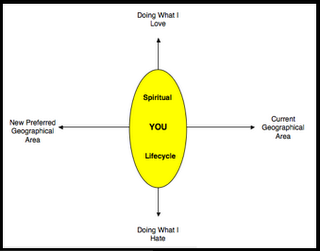
Future-Proof What You Love, Strike It Rich and Mine the Mother Lode
Chapter Four: The Tribal Territories
By Steve Howard, CKO
The Knowledge Labs
Table of Contents
Chapter One: Basecamp
Chapter Two: The Ridge
Chapter Three: The Outpost
Chapter Four: The Tribal Territories
“But remarkably, Jed and the Devil actually look very similar. But they say there’s a little bit of the Devil in everybody. But this resemblance is a little striking for me. It kinda reminds me of myself, actually. But from everything that happens in life, I’ve learned this and I’m at least 10, is that there’s a lot of wreckage from some things and this cop, Officer Carmichael, he had a life.”
Neil Young & Crazy Horse “Greendale”
DOUBLE NICKEL RANCH. We all enter a crossroads in our lives, each from our own, unique life experience. Even those in the same life stage come to seek a different set of options depending upon their current situation.
Journal of 2020 Foresight: In Basecamp Pathfinder helps people listen to their little voices.
Lone Eagle: That’s true. Choosing the right path for them depends on their calling, strengths and weaknesses and their current condition.
J2020F: Give me some examples.
Eagle: Some will have plenty of time to recover from a setback, but others will risk their life savings.
J2020F: So, they’ll be concerned about how realistic their plans are, and if they can stand up against positive and negative scenarios.
Eagle: That’s right. Others have never married. Some are childless. Some married young and others are divorced. Some are widowed. Some have a full house, others in empty nests.
J2020F: So, the impact of their choices affects others living with them for some, but not for others.
Eagle: Don’t forget physical and career fitness aspects.
J2020F: What do you mean?
Eagle: While some are more fit than ever, others are ill and ailing. Many are in rewarding careers, while still others seek change.
J2020F: It’s easy to imagine that some are wealthy, but many others are just getting by. Some are mothers who are just starting or re-starting careers.
Eagle: Yes. Others are career women just starting motherhood. Some are trying to beat the clock, their fertility deadline. Others have many pregnancies behind them and face rising college tuitions.
J2020F: Some are overachievers just beginning to balance out, right?
Eagle: Yes, and still others are laid-back belatedly trying to make some money before it is too late.
J2020F: That's why you start from the inside out, right?
Eagle: Pathfinder helps them clarify their intentions, purpose, and aspirations.
J2020F: And these scenarios help them harness uncertainty and change?
Eagle: Yes, so the when the “big bang explodes” it propels them to their next destination, rather than blows up everything they've worked for along the way.
J2020F: The big bang?
Eagle: Sorry. Trailblazer likes to describe these kinds of decisions as having a long fuse that’s lit. Unfortunately, it’s hard to tell if the choices you make today are the right ones, because the timeframe is too long to the final results.
J2020F: And thebig bang means that if you haven’t saved enough today for your retirement down the road, your golden years may be made of fools gold
Eagle: To test shifting futures, we construct scenarios. Mine ask the question: Can’t we follow our passions and still find the gold at the end of the rainbow?
J2020F: So the four scenarios, then …
Eagle: That we care the most about exist at the intersections of “Doing What I Love” -- instead of what I am forced to do – “What I Hate,” in the last chapters of our life, while “Living Where I Want” or “Living Where I Am.”
J2020F: Let's explore the combinations, then, shall we?
Got Knowledge?
Copyright ©2002 - 2006 Aarnaes Howard Associates. All rights reserved worldwide.
1:20 PM
Tuesday, July 18, 2006
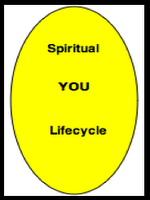
The Adventure Always Starts from Within
Chapter Four: The Tribal Territories
By Steve Howard, CKO
The Knowledge Labs
Table of Contents
Chapter One: Basecamp
Chapter Two: The Ridge
Chapter Three: The Outpost
Chapter Four: The Tribal Territories
“Cousin Jed is driving his beautiful funky car down Highway 1. Just at the edge is where Jed gets stopped by Officer Carmichael. That’s where Jed killed him. When I was writing this I had no idea what I was doing, so I was just as surprised as you are. Jed went to jail and I guess he’s still there. And you know who else is there.“
Neil Young & Crazy Horse “Greendale”
DOUBLE NICKEL RANCH. The path forward is never as easy as planned, especially if you may chose to or are forced to work through part of your retirement years. Each of us who have reached middle age, or beyond, realizes that we have sacrificed a part of ourselves just to make a living.
Journal of 2020 Foresight: Over the next five years, we all have an opportunity to realize a significant portion of our dreams. But, what is right for me isn’t necessarily right for you.
Pathfinder: Exactly. What’s right for you? What do you want to do?
Do you want to pursue a hobby or craft? What about a bed and breakfast business you'd like to start? Or do you have a passion for a charitable organization you'd like to support? How about travel to the four corners of the world or studying subjects you never took in college -- or both?
Eagle: I’ve found that exploring issues requires reflection time, but out of them will emerge a new dream that inspires you. And vision fuels the future you want.
Pathfinder: For the first time in your life, you may no longer need a house that's dedicated to family, located in a good school district, or a convenient distance from the office. As Harry Dent asks, “Where have you always wanted to live? On an island? In the mountains? In a pied-à-terre downtown, near restaurants, museums and shops?”
J2020F: The possibilities are endless, but you would be wise to consider long-term trends in your decision – based upon our last discussion.
Pathfinder: And lucky for us, much of the hard work had been done through the fleshing out of four scenarios that describe Baby Boom futures – we’ve called them the Lone Eagle Scenarios.
Eagle: I guess that’s my cue to walk through them.
J2020F: Please do. Trailblazer described them as stories that you and Explorer wrote, originally in 1997, right?
Eagle: Yes. Explorer and I had just completed Basecamp with Pathfinder and our next step was to meet with Trailblazer at The Ridge to future-proof two different options.
Pathfinder: The major difference boiled down to your plan to build “Mobile Knowledge Products” and in the process, figure out if you could do what you love most in a much higher quality of life community.
Eagle: That’s right, establishing “Mobile KnowCos.” And Explorer wanted to return to corporate life as a change advocate. In my scenarios, I’d describe him as “Staying Put and Doing What He Loved.”
Pathfinder: In his four scenarios, you would most fit his “Agent” or one of his “Academic” talent-clusters.
J2020F: In either set of future stories, you examine your choice to follow one of eleven paths you can take based on a whole host of personal life and work life considerations critically important to you at your current stage in life.
Pathfinder: That’s right. The original expedition based in Basecamp called this approach the “Future by Life Design.” Whereas, Trailblazer monitors the outer rings – the macro forces, we begin with your core at the center.
Eagle: What I discovered is when you peal away the layers to your inner most foundations it reveals a spiritual source housed in a body within a specific phase of a lifespan.
J2020F: So this is our source of inspiration.
Pathfinder: The world is a place full of interesting options for those who plan to fully explore their potential. The adventure starts from within.
Eagle: And four different stories can be told about your future journey. Each tells a different way that those options play out while you are doing what you love.
Pathfinder: Which lay out the foundation for contingency plans A, B, C & D.
J2020F: Is that how I can future-proof my plans?
Got Knowledge?
Copyright ©2002 - 2006 Aarnaes Howard Associates. All rights reserved worldwide.
7:40 AM
|
|
| |
|
|
|